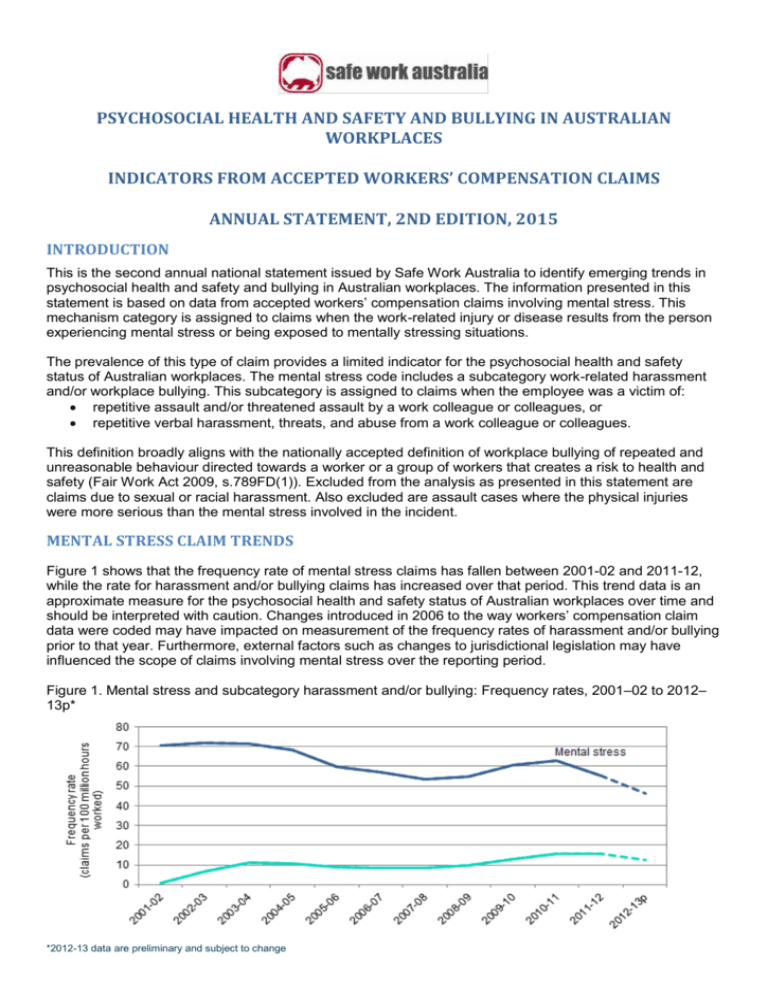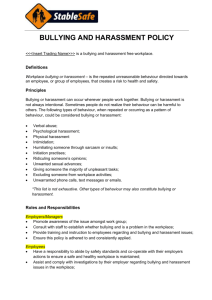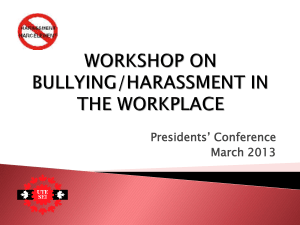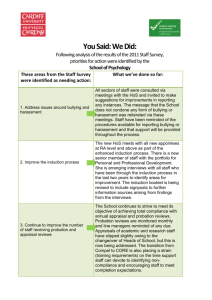Psychosocial Health and Safety and Bullying in Australian Workplaces
advertisement

PSYCHOSOCIAL HEALTH AND SAFETY AND BULLYING IN AUSTRALIAN WORKPLACES INDICATORS FROM ACCEPTED WORKERS’ COMPENSATION CLAIMS ANNUAL STATEMENT, 2ND EDITION, 2015 INTRODUCTION This is the second annual national statement issued by Safe Work Australia to identify emerging trends in psychosocial health and safety and bullying in Australian workplaces. The information presented in this statement is based on data from accepted workers’ compensation claims involving mental stress. This mechanism category is assigned to claims when the work-related injury or disease results from the person experiencing mental stress or being exposed to mentally stressing situations. The prevalence of this type of claim provides a limited indicator for the psychosocial health and safety status of Australian workplaces. The mental stress code includes a subcategory work-related harassment and/or workplace bullying. This subcategory is assigned to claims when the employee was a victim of: repetitive assault and/or threatened assault by a work colleague or colleagues, or repetitive verbal harassment, threats, and abuse from a work colleague or colleagues. This definition broadly aligns with the nationally accepted definition of workplace bullying of repeated and unreasonable behaviour directed towards a worker or a group of workers that creates a risk to health and safety (Fair Work Act 2009, s.789FD(1)). Excluded from the analysis as presented in this statement are claims due to sexual or racial harassment. Also excluded are assault cases where the physical injuries were more serious than the mental stress involved in the incident. MENTAL STRESS CLAIM TRENDS Figure 1 shows that the frequency rate of mental stress claims has fallen between 2001-02 and 2011-12, while the rate for harassment and/or bullying claims has increased over that period. This trend data is an approximate measure for the psychosocial health and safety status of Australian workplaces over time and should be interpreted with caution. Changes introduced in 2006 to the way workers’ compensation claim data were coded may have impacted on measurement of the frequency rates of harassment and/or bullying prior to that year. Furthermore, external factors such as changes to jurisdictional legislation may have influenced the scope of claims involving mental stress over the reporting period. Figure 1. Mental stress and subcategory harassment and/or bullying: Frequency rates, 2001–02 to 2012– 13p* *2012-13 data are preliminary and subject to change MENTAL STRESS CATEGORY BREAKDOWN Table 1 provides key statistics for claims involving mental stress as the main mechanism of injury or disease for 2011-12 broken up by mechanism subcategory. It shows that, while mental stress claims are relatively uncommon, the median time lost and median direct cost associated with mental stress claims are higher compared to those observed for all workers’ compensation claims. Table 1. Number, time lost, direct cost, frequency rate and incidence rate for mental stress claims, 2011-12 Sub-category of mental stress Work pressure Work related harassment and/or workplace bullying Exposure to workplace or occupational violence Exposure to a traumatic event Other mental stress factors Other harassment Suicide or attempted suicide Total all mental stress Total all accepted claims No. of claims 2 435 Median time lost (working weeks) 10.6 Median direct cost ($) 23 000 Claims per 100 million hours 18 Claims per 10 000 employees 3.1 2 070 9.2 20 900 16 2.7 1 055 915 655 225 10 9 610 300 565 3.2 3.4 3.6 5.7 3.0 8.2 0.6 7 600 7 500 9 300 11 500 9 600 15 400 1 413 8 7 5 2 0 55 1724 1.4 1.2 0.8 0.3 0.0 9.3 289.5 Data are presented for 2011–12 rather than 2012–13p because the time lost from work and the direct cost associated with a compensation claim are generally not finalised until some time after the end of the financial year in which the claim was submitted. Note that workers’ compensation data reflect the year the claim was lodged, not the year in which the incident occurred. There may be a significant lag for mental stress claims. **Mental stress subcategory data do not include information from Victoria. However the total mental stress data do include Victorian information and are therefore national figures. MENTAL STRESS CATEGORIES BY SEX The frequency rate of workers’ compensation claims for harassment and/or bullying made by female employees was three times higher than the rate of these claims made by males. Similarly, the rate of claims made by females for exposure to workplace or occupational violence and work pressure were twice the rate of similar claims made by males. Figure 2. Frequency rates by sex and mental stress subcategory, 2010–11 to 2012–13p combined Work pressure Work related harassment &/or workplace bullying Exposure to workplace or occupational violence Exposure to a traumatic event Other mental stress factors Females Males Other harassment 0 5 10 15 20 Claims per 100 million hours worked 25 30 HARASSMENT AND/OR BULLYING BY OCCUPATION & INDUSTRY Occupations with a high risk of exposure to work-related harassment and/or work place bullying include clerical and administrative workers; other information and organisation professionals; and prison officers. Figure 3. Top ten occupations for experiencing harassment and/or bullying, 2010–11 to 2012–13p combined Other Misc Clerical & Administrative Workers* Other Information & Organisation Professionals Prison Officers Police** Welfare Support Workers Social Workers Other Miscellaneous Labourers Enrolled & Mothercraft Nurses Other Specialist Managers Education Aides 0 20 40 60 80 100 120 Claims per 100 million hours worked Occupations are limited to those associated with more than 50 claims. *This group includes logistics clerks and miscellaneous clerical and administrative workers. **Excludes Western Australia Industries with high rates of claims involving work-related harassment and/or work place bullying include medical and other health care services; civic, professional and interest group services; and public order and safety services. Figure 4. Industries with high frequency rates of harassment and/or bullying, 2010–11 to 2012–13p combined Other Health Care Services Civic, Prof & Other Interest Grp Services Public Order and Safety Services* Local Government Administration Residential Care Services State Government Administration Hospitals School Education Clubs (Hospitality) Central Government Administration 0 10 20 30 40 50 60 70 Claims per 100 million hours worked Industries are limited to those associated with more than 50 claims. *Excludes Western Australia RESEARCH The Australian Workplace Barometer showed that 6.8% of Australian workers reported they had been bullied at work in the six months prior to being surveyed, with 3.5% experiencing bullying for longer than a 6 month period (Dollard et al. 2012). Research indicates that the number of compensation claims for mental disorders lodged due to workrelated mental stress may underestimate the size of the problem, particularly in lower socio-economic jobs (LaMontagne et al., 2010). The Australian Bureau of Statistics Work-related Injuries Survey 2009–10 showed that 67% of employees eligible for workers’ compensation reported they experienced mental stress but did not apply for workers’ compensation (Australian Bureau of Statistics, 2010, Work Related Injuries, cat. no. 6324.0). OTHER INFORMATION The House of Representatives Standing Committee on Education and Employment report Workplace bullying: “We just want it to stop”, tabled on 26 November 2012, contained 23 recommendations that focus on: defining what bullying is and is not promoting and strengthening existing legislative and regulatory frameworks improving workplace cultures enhancing tools for the prevention and early resolution of workplace bullying incidences, and providing an individual right of recourse. Recommendation 18 of the report states “The Committee recommends that Safe Work Australia issues an annual national statement which updates any emerging trends of its collated data from each of the state and territory regulators, and the Commonwealth, with respect to psychosocial health and safety generally and workplace bullying specifically.” This statement is produced annually in repsonse to this recommendation. For the full report go to the Parliament of Australia website. THE FAIR WORK COMMISSION From 1 January 2014, a worker (including an employee, contractor, apprentice or volunteer) who is covered by the Fair Work Act 2009 and reasonably believes they have been bullied at work may apply to the Fair Work Commission for an order to stop the workplace bullying. More information is available on the Fair Work Commission website. OTHER RELATED SAFE WORK AUSTRALIA PUBLICATIONS These and other reports are available at swa.gov.au: The Guide for Preventing and Responding to Workplace Bullying and Dealing with Workplace Bullying, November 2013 Dealing with Workplace Bullying - A Worker’s Guide, November 2013 The Incidence of Accepted Workers’ Compensation Claims for Mental Stress in Australia, April 2013 DATA SOURCE Data are sourced from the National Dataset for Compensation-based Statistics (NDS) and include all accepted workers’ compensation claims for temporary incapacity, permanent incapacity and fatalities made under state, territory and Commonwealth Government workers’ compensation Acts. Claims are coded according to the Type of Occurrence Classification System 3rd Ed. Revision 1 (TOOCS). Industry level data are presented using the Australian and New Zealand Standard Industrial Classification (ANZSIC) 2006. Data presented for mental stress are national figures but data for subcategories of mental stress exclude Victoria because their data are not coded to that level of detail. Data for 2012-13 are preliminary (denoted by the letter ‘p’) and subject to future adjustment. Workers’ compensation statistics provide the only national administrative data indicators for psychosocial stressors in Australian workplaces. The hours worked data used to calculate frequency rates were provided by the Australian Bureau of Statistics in 2014.

![Bullying and Harassment Advisor role des[...]](http://s3.studylib.net/store/data/006976953_1-320eb77689e1209d082c9ec2464350ee-300x300.png)






